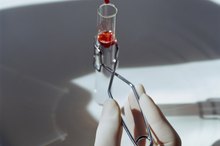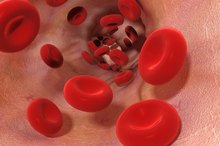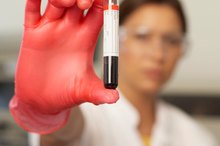What Is a Normal Oxygen Level for an Adult Female?
Oxygen is necessary to sustain your life. The normal oxygen levels between women and men do not vary; oxygen is needed equally by both genders. However, the factors that influence your body's ability to take in and carry oxygen may be affected by your gender. Understanding your needs and gender influences can help keep your oxygen levels normal and healthy.
Oxygen Saturation
The term oxygen saturation refers to the amount of oxygen your blood is carrying. When your blood circulates, it goes to each of your cells and picks up carbon dioxide, a byproduct of metabolism. It brings this carbon dioxide to the lungs, where it is exchanged for oxygen. Your lungs exhale the carbon dioxide, and your blood delivers the oxygen to the cells that need it.
- The term oxygen saturation refers to the amount of oxygen your blood is carrying.
- Your lungs exhale the carbon dioxide, and your blood delivers the oxygen to the cells that need it.
Normal Levels
Low O2 Saturation When Exercising
Learn More
Normally, when your blood circulates to your lungs, 95 to 100 percent of your red blood cells are able to grab oxygen molecules, reports Harvard Health Publications 2. This is the normal oxygen level for an adult female and can be measured using a device known as a pulse oximeter. This is a small instrument that attaches to one of your fingers and is able to measure the amount of oxygen inside your blood in a non-invasive manner.
- Normally, when your blood circulates to your lungs, 95 to 100 percent of your red blood cells are able to grab oxygen molecules, reports Harvard Health Publications 2.
- This is a small instrument that attaches to one of your fingers and is able to measure the amount of oxygen inside your blood in a non-invasive manner.
Females and Anemia
If your oxygen levels are low and you are a female, this may be an indication of anemia. Anemia is a condition characterized by low iron intake. Without iron, your body cannot produce red blood cells, and consequently, your blood cannot carry the oxygen it should. Women, especially adult women before menopause, need a larger amount of iron than men because iron is lost through menstruation. An adult female needs to take in 18 mg per day of iron, compared with just 8 mg for men, according to the Office of Dietary Supplements from the National Institutes of Health 4. Iron is found in meat, beans and fish.
- If your oxygen levels are low and you are a female, this may be an indication of anemia.
- An adult female needs to take in 18 mg per day of iron, compared with just 8 mg for men, according to the Office of Dietary Supplements from the National Institutes of Health 4.
Other Influences
How Many Calories & Grams of Fat Should a Female Consume?
Learn More
Chronic obstructive pulmonary disease, or COPD, may also be a cause of low oxygen level 5. COPD encompasses any number of conditions that make it difficult for your body to absorb oxygen through the lungs. According to NYTimes.com, the number of women suffering from COPD is increasing. Women are more sensitive to pollution and smoke, two causes of COPD, and seem to be far more affected by the disease, experiencing more severe symptoms and a worse quality of life than men. They also are more likely to be hospitalized and to die from the disease.
- Chronic obstructive pulmonary disease, or COPD, may also be a cause of low oxygen level 5.
- Women are more sensitive to pollution and smoke, two causes of COPD, and seem to be far more affected by the disease, experiencing more severe symptoms and a worse quality of life than men.
Related Articles
References
- "Anatomy and Physiology"; Kenneth S. Saladin; 2004
- MayoClinic.com; Hypoxemia; Mayo Clinic Staff; Sept. 25, 2010
- Office of Dietary Supplements: Dietary Supplements Fact Sheet: Iron
- NYTimes.com: Chronic Obstructive Pulmonary Disease Complications; April 2009
- McGill University, Office for Science and Society, "Under the Microscope: Blood"
- Collins JA, Rudenski A, Gibson J, Howard L, O'Driscoll R. Relating oxygen partial pressure, saturation and content: the haemoglobin-oxygen dissociation curve. Breathe (Sheff). 2015;11(3):194–201. doi: 10.1183/20734735.001415
- Gossman W, Alghoula F, Berim I. Anoxia (Hypoxic Hypoxia) [Updated 2019 Jul 11]. In: StatPearls [Internet]. Treasure Island (FL): StatPearls Publishing; 2019 Jan-.
- Giaccia AJ, Simon MC, Johnson R. The biology of hypoxia: the role of oxygen sensing in development, normal function, and disease. Genes Dev. 2004;18(18):2183–2194. doi: 10.1101/gad.1243304
- Leach RM, Treacher DF. Oxygen transport-2. Tissue hypoxia. BMJ. 1998;317(7169):1370–1373. doi: 10.1136/bmj.317.7169.1370
- Hafen BB, Sharma S. Oxygen Saturation. [Updated 2019 Jun 2]. In: StatPearls Treasure Island (FL): StatPearls Publishing. 2019 Jan.
Writer Bio
Laura Niedziocha began her writing career in 2007. She has contributed material to the Stoneking Physical Therapy and Wellness Center in Lambertville, N.J., and her work has appeared in various online publications. Niedziocha graduated from Temple University with a Bachelor of Science in exercise science. She also has her Associate of Arts in communications from the Community College of Philadelphia.









